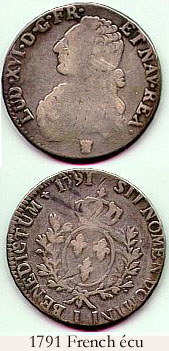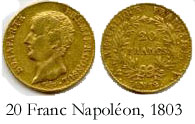APAC100
From Marist Studies
Jump to navigationJump to search
Excursus B : money matters
Printer-friendly version of Excursus B

- The most often mentioned currency in the correspondence from Oceania is the French franc. In Australia and New Zealand the pound sterling was the common currency although, perhaps because of the whalers, the Mexican quadruple too was in use in the Bay of Islands. The Frenchmen often kept thinking in terms of their familiar francs.
- The pound swung for a long time around 25 francs, which puts the franc at about tenpence.[1] In 1851 Rocher wrote to Colin from Sydney that due to the gold rush he had to pay £ 26 for a ton of flour, and 30 centimes for a loaf of bread, threepence would have meant nothing to Colin.[2]
- Sometimes there is mention of the sou which is five centimes, the écu (scudo in Italian), which was a coin equivalent to three francs.[3] A Napoléon was a coin of 20 francs. Around South America the piastre, equivalent to 5.5 francs, was often used.
- Gold was considered the basic standard for all currencies, and often money was sent in the form of gold coins. The gold coins in circulation in South America were Spanish, Mexican and Colombian so-called quadruples or doublons of one ounce of gold. In November 1836 they were traded in Paris for 84 or 85 francs, but the exchange rate varied according to the amount in circulation.[4]
- The 8.700 francs that Colin sent in May 1837 came to 100.72 ounces, which means just over 86 francs for one ounce of gold.[5]
- In 1839 Bataillon wrote that the Methodist missionaries (probably in Tonga) were paid a thousand francs (for man and wife) a year by their home organization. There was a special allocation for each child.[6] In 1848 the upkeep of a Catholic missionary too was set at 1.000 francs a year. [7] Mass stipends in France were one franc and the missionaries were scandalized to hear that priests in Valparaiso demanded five francs.[8]

- Relating money values of the 1830’s and 1840’s to today’s money is a hazardous undertaking.
- Around 1830 priests in France would receive 1.000 francs a year. That was considered low, compared to other European countries. A tailor’s wage could be as low as 7 francs or as high as 20. A silk weaver could earn 900 francs a year, a qualified schoolteacher 600 and a university professor 3.000. A simple pair of shoes cost 4 francs and in rural France people paid 10 francs for a pig and 27 for a cow.[9]
- We probably get a realistic picture if for one 1840 franc we think of something like € 10 or US$ 15, and for a sou fifty eurocent[10]. For the piastre we can then think roughly of € 55 or US$ 82.50.[11] And for one pound sterling (1840) we can think of € 250 or US$ 375.
Notes
- ↑ Cf. Dillon writing to Colin, quoted in Wiltgen, op. cit. p. 217. in 1841 Fr. Garin writes to Colin of a gift of 30 pounds and explains: 600 francs; probably an unthinking remark, LRO, doc. 111 [11].
- ↑ LRO, doc. 1062 [12].
- ↑ Above, p. 69. LC I, doc. 230.
- ↑ Cf. LRO, doc. 7 [14] & LRO, doc. 59 [4]. In 1840 the doublon was 87 francs in Tenerife, Pezant to Colin, 09.03.1840.
- ↑ Pompallier to Meynis, 17.03.1839, OPM, H30, 000867.
- ↑ LRO, doc. 38 [10].
- ↑ Bernard Bourtot, Colin, les missions et leur financement en 1848, in Document SM Nr. 71, April 2007. Centre de Documentation Mariste, 6, rue Jean Ferrandi, 75006 Paris, p. 23.
- ↑ Baty to Colin, 12.01.1839. Cf. above p. 93.
- ↑ A. Greiler, Finance for Mission, Colin, the Society of Mary and Oceania, 1836 to 1854, research paper, June 2008, APM, p. 5.
- ↑ Bourtot, loc. cit. puts the 1840 franc higher, at between 12 and 15 Euro. A Wikipedia article lets the franc between 1830 and 1850 move from € 2.20 to € 2. 53!
- ↑ Exchange value between dollar and euro as of mid-2008.
| Previous Section | A Piety Able to Cope | Next Section |